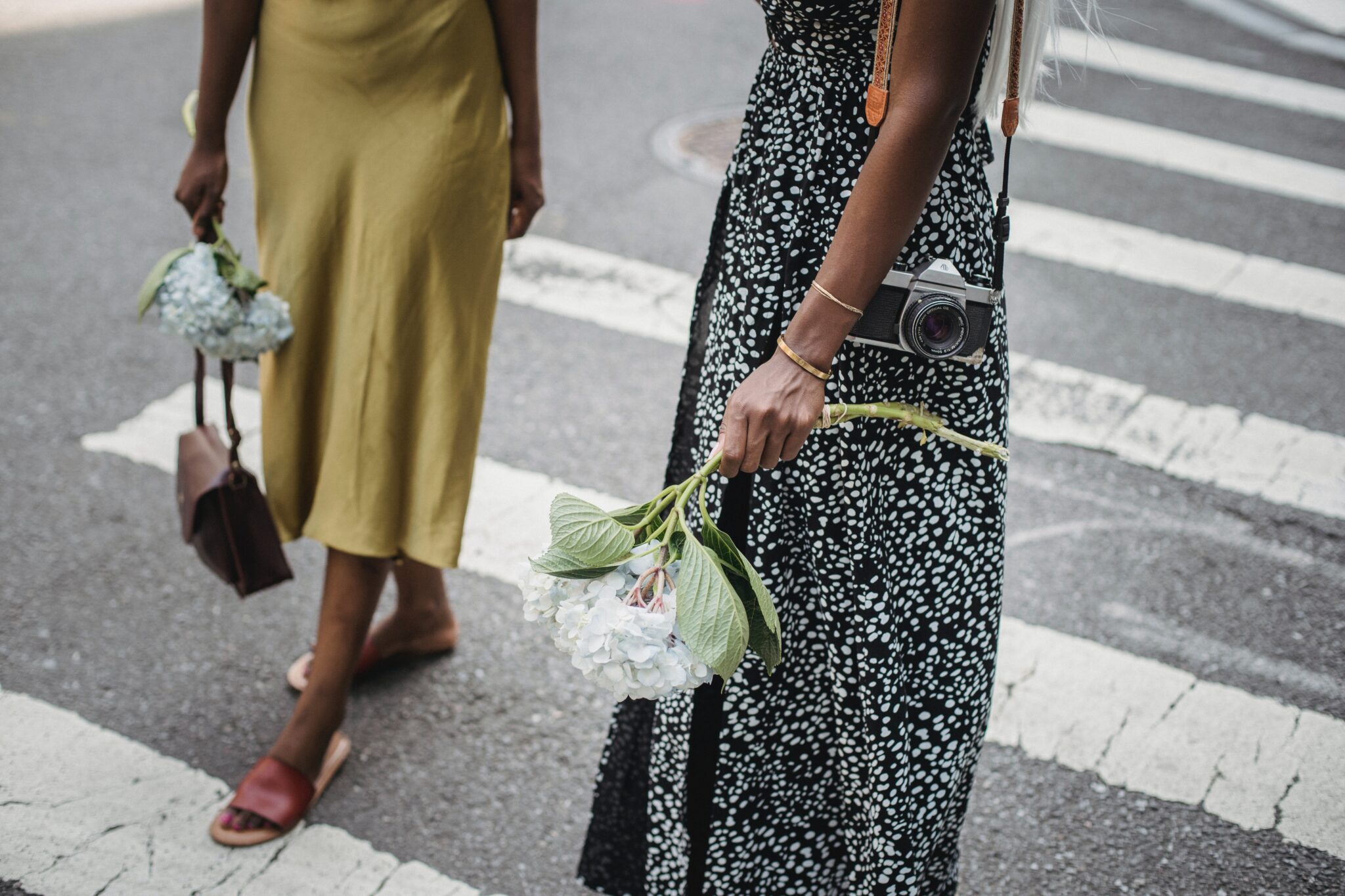Over the past couple of months, one phrase has dominated the lexicon of the fashion community: “quiet luxury.” Simply put, quiet luxury is the latest style craze, characterized by minimalist silhouettes, a muted color palette, and a high price tag. Of course, such demure, yet expensive garments are nothing new. The world’s most notorious billionaires, including the likes of Mark Zuckerberg and Bill Gates, have famously worn plain t-shirts worth hundreds for years.
Likewise, those who belong to the “old money” echelon of society or, rather, a top tier of the upper-class built on generational wealth, have long championed timeless, well-crafted, and under-the-radar styles. Their signatures include luxe knits in neutral tones, tailored suiting with clean lines, and structured accessories, constructed out of only the softest leathers.

Certain highbrow labels including The Row, Bottega Veneta, and Jil Sander have made subtlety a core component of their respective brand identities. Choosing to highlight craftsmanship, their collections typically feature a color palette largely composed of toned-down hues, astonishingly chic leather bags, and simple, yet classic silhouettes.
What makes this new trend particularly shocking is how contrary it runs to the flamboyant styles that have dominated fashion over the past couple of years. Recently, we have witnessed some of the most prominent influencers and celebrities swapping the maximalist and label-ridden aesthetic that has been a mainstay in the industry for quite some time, for a more demure one.
For instance, during a recent trip to Paris, Kylie Jenner stepped out in a series of understated looks, including a sleek black Bottega Veneta halter dress and a breezy white cotton frock from Alaïa. This level of subtlety was new for the youngest member of the Kar-Jenner family, whose previous outfits have largely featured bold colors, extravagant silhouettes, and experimental styling choices.

And, of course, no conversation about quiet luxury is complete without discussing the queen of the trend herself: Gwyneth Paltrow. Her recent string of court appearances for a collision at a ski resort in 2016 saw her don a series of flawless quiet luxury looks, including a $1,815 cream-colored turtleneck from the Italian knitwear label Loro Piana, as well as a muted green coat from the Row and a clean-cut grey suit.
Naturally, the minimalist styles now favored by celebrities have also come to dominate the most recent runways, including those of the Resort 2024 season. For their latest Resort collection, the heritage Italian house Ferragamo and Creative Director Maximillian Davis presented a series of looks that were noticeably more subdued, but still just as luxurious as those of past seasons. Neutral hues and clean, classic silhouettes abounded, making it clear that Davis is, no doubt, doing his part to promote the quiet luxury trend.
The New York-based label Khaite was another brand to participate in the turn towards minimalism. Although Khaite has famously existed on the more understated end of the aesthetic spectrum, with its Resort 2024 collection, Creative Director Catherine Holstein took this commitment to a new level. With a color palette consisting of largely black, white, and beige, and a slew of expertly constructed sleek leather pieces, Khaite epitomized the shift towards high-brow simplicity.
Perhaps the most shocking show of the most recent season was that of Givenchy. For the French label’s Resort 2024 offering, Creative Director Matthew Williams shifted away from the flamboyant Y2K ensembles that he had presented in the last few seasons and chose to feature more timeless, toned-down styles. These included clean-cut leather dresses, phenomenally tailored suits, and more simplistic denim pieces.
But how did this intensely subtle aesthetic so easily overtake and replace the flashy ethos that has defined the fashion of the 2020s thus far? And why over the course of a few short months, have the luxury and celebrity worlds so quickly turned their backs on the bold styles that they seemingly couldn’t get enough of in the few years prior?
The swift rise of quiet luxury can likely be attributed to a few broader societal trends that facilitated its development in recent months. One such trend is social media’s ever-present fascination with displays of wealth.
The rise of social media over the course of the past decade has undeniably led to a greater emphasis on individualism and, more specifically, self-image. Naturally, this increase in the importance of one’s public-facing online persona spawned the near-universal trope among influencers and digital creators to curate posts in which they looked undeniably attractive, successful, and, above all, rich.
Of course, this desire to appear wealthy sparked the much-debated movement in the fashion world dubbed, “logo-mania.” Logo-mania refers to the trend of splattering a brand’s logo, signature symbol, or name across every inch of an outfit.
Such logo-ridden garments provided the ideal solution for emerging influencers to project an image of success in the most blatant manner possible. The promotion of logo-mania by various online personalities eventually had a trickle-down effect and caught on among the masses merely posting on their personal accounts. Therefore, if you logged on to nearly any social media platform in the recent past, your feed was likely inundated with creators, family, friends, and acquaintances donning a look featuring Gucci’s “GG” diamond print, Fendi’s double F logo, or Versace’s Medusa head motif.
However, as these obvious displays of wealth became more and more commonplace, they lost their luster. Quite simply, the ubiquity of these logo-adorned pieces (both real and fake) deprived them of their original power as outward symbols of financial success. Thus, the influencer community was forced to adopt the aesthetic of an even more exclusive echelon of society: the “old money” class.
Over the past few months, the prominence of logos on social media has gradually diminished as online personalities have sought to demonstrate their wealth in a manner most similar to those of the world’s richest and most financially established caste. They have slowly begun shifting their fashions in a more subtle direction, not only selecting pieces that are understated in color and shape but also sourced from brands where craftsmanship and timelessness (and not a logo) are the foremost identifiers. As a result, quiet luxury has come to dominate the social media fashion scene and, by extension, the overarching tastes of the whole fashion world.
Another broader movement that has played a significant role in the rise of quiet luxury is sustainability. It’s no secret that the fashion industry is an extremely wasteful one and, with the recent proliferation of numerous “fast-fashion” brands, it has become increasingly more so. In essence, fast-fashion labels are those that practice the rapid replication, mass-production, and low-cost sale of popular garments from recent runways or social media posts.
Due to the fast pace of their construction, the garments are typically not durable and their trend-focused design means that they will cease to be in style after just one season. Both of these factors considered, fast fashion garments are likely to end up in landfills after just a handful of wears.
At the same time, the desire to keep the cost of garments low means that cheap, toxic textile dyes and harmful synthetic fabrics are used. The use of such dyes has led the fashion industry to become one of the main polluters of clean water on a global scale. Similarly, inexpensive textiles, including polyester, are derived from fossil fuels and shed plastic microfibers that can find their way into natural bodies of water when washed.
As these facts have become increasingly well-known in the past couple of years, many consumers have begun to turn away from fast fashion and, instead, shop with sustainability in mind. This has, in turn, led many to purchase pieces that are not only crafted in a more environmentally conscious manner, but that are also durable, and will never go out of style.
For those looking to shop according to these more sustainable guidelines, quiet luxury, or at the very least the quiet luxury aesthetic, is a natural fit. As a trend-focused primarily on promoting classic styles and good craftsmanship, it has been the most obvious answer to fashion’s current push for sustainability.
Although quiet luxury can easily be seen as just another “trend” in the mainstream fashion world, it should be considered more significant than that. Thus far, it has not only served to honor the advanced levels of craftsmanship that luxury fashion is typically known for but also the current push for the use of more sustainable means and methods in every aspect of society. With these considerations in mind, quiet luxury should not merely be seen as a temporary style movement, but a more permanent shift in the way the fashion industry’s consumers select and style their clothes.














